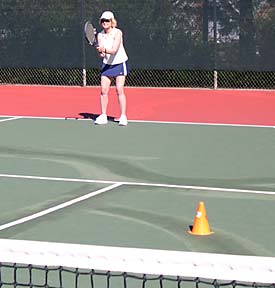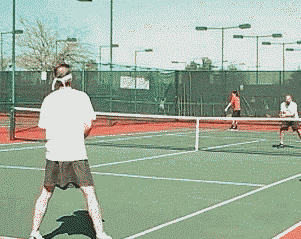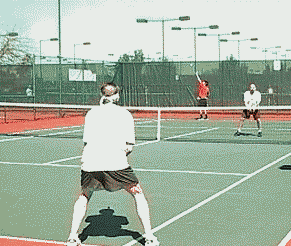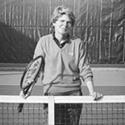|
TennisOne Lessons Go Ahead, Color Outside the Lines by Pat Blaskower Some players are so intimidated by the thought of invading their partner's court that they become rooted to the spot they occupy, slowly but surely turning into what I call "orange cones." We all need to remember that first and foremost, tennis is really about managing our mistakes and having the emotional fortitude to accept that mistakes are inevitable and unavoidable. They do not make us inept competitors.
I remember teaching a lesson on poaching one day when I worked at The Mill Valley Tennis Club in Northern California. The net player was a very timid soul who was very reluctant to take any risks or call attention to her self in any way. Her partner was, shall we say, not lacking in the self-confidence department. After what seemed to be an interminable crosscourt rally and many exhortations on my part for the net player to cross and intercept the ball, the poor soul finally did - and missed the shot. Her partner put her hands on her hips, glared, and announced, "You know, I had a point working there. "I would hazard a guess that it was a very long time before this chastened net player ever tried that again. Fear of retribution from a partner and fear of making an egregious error and looking like an idiot are major causes of net players adopting the stance of an orange cone rather than risking humiliation. How to be a Brilliant Success at the Net First of all, "poaching" is not a great term for crossing in front of your partner to attempt to end the point. One could argue that "poaching" has a pejorative connotation because it is illegal to poach hunted quarry on posted property. I would rather a player think of this movement as an assignment on the court that is NOT optional. If your partner, who in this circumstance is the crosscourt player, whether she be server, receiver, or volleyer in the middle of the point, has gone to all the trouble to set things up so that a wounded duck is approaching your side of the net, completing your part of the contract is mandatory. You cannot simply crawl into your cocoon and assume that your partner can make a better shot.
It is important, however, that BOTH partners understand the contract. You simply cannot play proper doubles with a selfish crosscourt player who resents your every attempt to enter the point. Every time you cross in front of her you create a new and better angle AND you cut off the recovery time across the net. However, there are some rules to be followed so that you do not go careening off the court after the wrong ball and end up feeling that adopting a posture that includes having beady eyes from under the bench is a way better idea. Server's Partner As the server's partner, you should start about midway into the service box. When you hear your partner serve the ball, move STRAIGHT toward the net. As you are moving, note whether the receiver is preparing his racquet to his inside or to his outside (if your partner is serving to the deuce court to a right-handed opponent, the OUTSIDE will be his forehand and the INSIDE will be his backhand). If the serve goes to the outside, shift slightly toward the alley and do not attempt a poach. If the serve goes to the inside, move to the center netstrap and prepare to pick one off. The biggest and most often made mistake in poaching is trying to move on the outside ball. Regardless of how close to you the ball seems, the angle is running away from you and you will NEVER catch up to it or be able to get the racquet face perpendicular to the ball. The outside ball may feel like a poach and smell like a poach, but it really isn't.
My students try it all the time, and when I stare at them, they say "Oh, I almost had it." My reply is always "E mail me when that works." Only poach when the serve is to the inside and you will be wildly successful. Your target is the opponent's alley toward which you are moving. Never hit back behind yourself because you are vulnerable in the alley you have just vacated. Most people think they should hit their poaches up the middle. Often it works, but I remind my students that there are two racquets in the middle and the ball very well might come back. The alley toward which you are moving is much safer. No one can catch up to that angle. Unless you and your partner have called for an "automatic switch," you are not obligated to take balls that are too low, too hard hit or too wide. You are freelancing, not committed, unless it looks like an easy ball on which you can hit down. If you don't take the ball for any of the above reasons, get back to your position quickly. Don't dawdle or turn around to check to see if your partner is able to make the play. If you hit the ball, continue across the net, following your poach, and your partner will effortlessly cross behind you. Remember, you are NOT obligated to race across the net just because you have made a preliminary move. You have the right to change your mind and retreat when you are freelancing. If your partner tells you that your movement bothers him, get another partner. He needs an orange cone for a companion on the court. Receiver's Partner This is a hugely more difficult proposition. Poaching (intercepting is a more positive word) after your partner returns serve is just as important as poaching after he has served. Believe and operate under the assumption that a volleyer cannot change the direction of a low ball.
If the server is a net rusher, and if your partner is able to play a low service return to his feet, the server will be forced to hit up on his volley. When looking to make this move as receiver's partner, be patient. Do not leave too early. Wait until the server's wounded volley is actually in the air, and then pounce on it, moving sharply on the diagonal and aiming your" putaway "directly into the server's partner's alley. Follow your ball so that your partner can cross behind you. Don't pause to admire the beauty of your shot. The biggest mistake players make trying to execute this move is leaving too early. If the server seriously misplays his volley by hitting it late, his shot will go behind you even though he did not mean it. Wait long enough to be sure that the floating volley is indeed headed crosscourt. Crossing on your partner's return is difficult to time correctly, but with practice, it becomes one of the most satisfying moves you can make on the doubles court. Again, think of it as fulfilling your part of the contract. If your partner makes an excellent service return, it is your job to intercept the next ball. Be brave. Have the courage to perform your part of the dance. And make sure to tell him "good setup." The Middle of the Point All of the above rules apply to the poach in the middle of the point. Your opponent can hit ground strokes behind you, but he cannot change the direction of a low ball aimed at his feet if he plays a volley or a half volley. Look for his racquet to drop below his knee as he begins to play his shot and move to the middle of the court in order to cut off the highest percentage play he has available. If you venture nothing, you do not discomfit your opponents nor do you ever force them to be more precise with the placement of their volleys. Move at the net. Make the enemy feel that there is very little space left to aim their shots. Make them watch you instead of the ball. The biggest mistake players make trying to execute this move is being too far away from the net to make the poach effective. Don't get baseline creep. Stay at the net and look for your opportunities. Make sure you follow your poach so that your partner can cross behind you. In all three scenarios I have made the point that you should follow your poach. If you do not, and your partner cannot cross, you are vulnerable in the middle and to the crosscourt lob if the ball comes back. Armed with a few guidelines and buckets of courage, there is no reason you cannot become a formidable net monster who inspires fear and awe in your opponents. Think of the risks of taking no risks. Don't be an orange cone. Color outside the lines. Your comments are welcome. Let us know what you think about Pat Blaskower's article by emailing us here at TennisOne.
|




 Pat was born in Jacksonville, Florida but raised in the Bay Area. She was always an excellent athlete and by the time she was three years old, she was holding a racquet. "My father decided I would be champion of the world." She followed his lead when she was ranked number 2 in Northern California as a junior. But by seventeen, Pat had given up tennis, "the product of an anxious parent."
Pat was born in Jacksonville, Florida but raised in the Bay Area. She was always an excellent athlete and by the time she was three years old, she was holding a racquet. "My father decided I would be champion of the world." She followed his lead when she was ranked number 2 in Northern California as a junior. But by seventeen, Pat had given up tennis, "the product of an anxious parent."